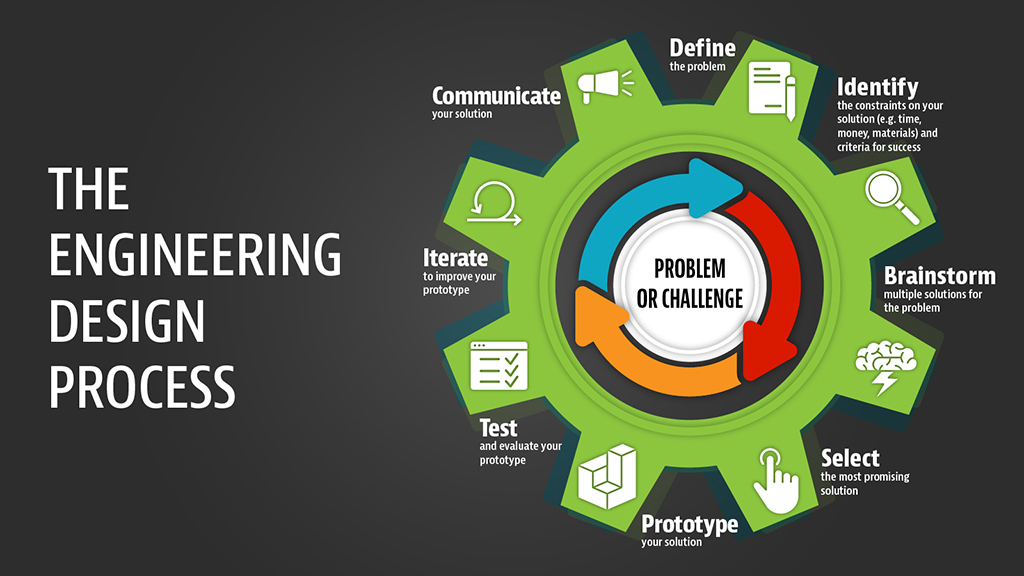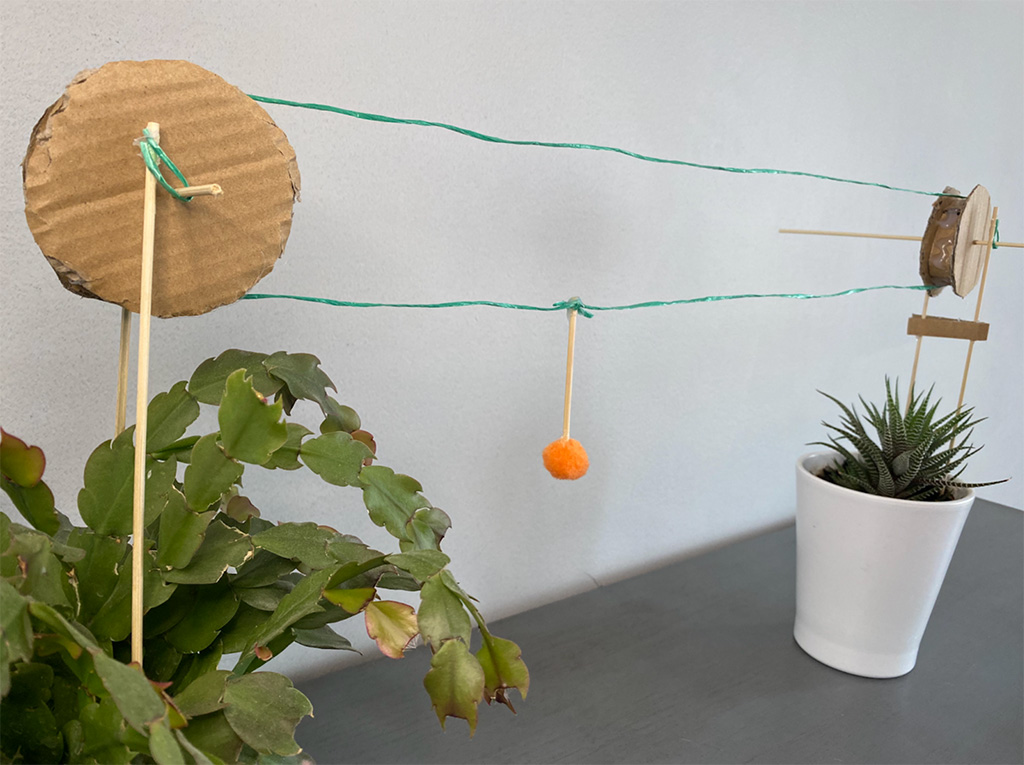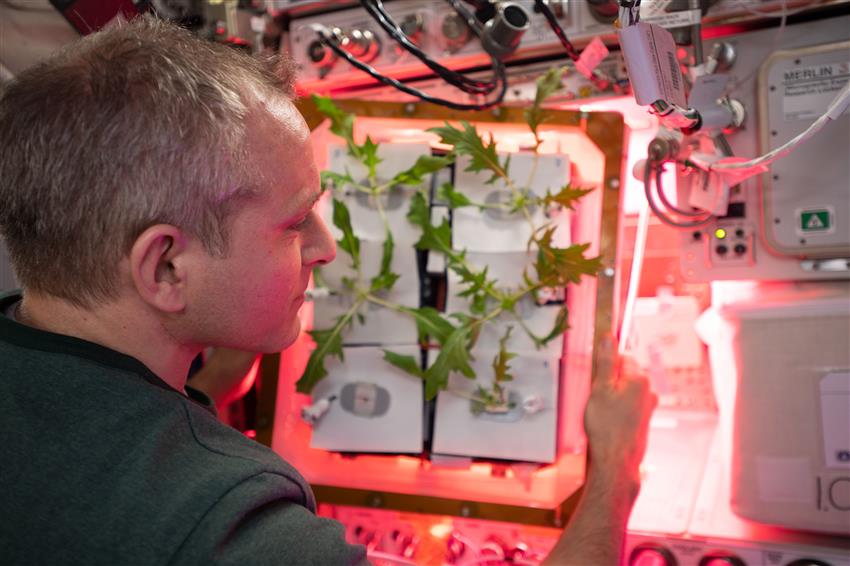Pollinating pulleys
Create a system for the Lunar Gateway that uses at least a simple pulley mechanism to pollinate plants in space. You can also add as many other simple mechanisms as you like to your system.

Text version of infographic entitled "The engineering design process"
The engineering design process
- Problem or challenge
- Define the problem
- Identify the constraints on your solution (e.g. time, money, materials) and criteria for success
- Brainstorm multiple solutions for the problem
- Select the most promising solution
- Prototype your solution
- Test and evaluate your prototype
- Iterate to improve your prototype
- Communicate your solution
Infographic entitled "The engineering design process". (Credit: Canadian Space Agency [CSA])
Define
As we prepare to travel to the Moon and eventually to Mars, we need to better understand how to grow food in space and on other planets.
When the wind blows on Earth, it can take the pollen from one plant to another to help grow new plants. Various insects and birds can also help the pollination process as they land on flowers and carry pollen onto the next flower. As a matter of fact, one of the most efficient pollinators is the bumblebee, because it reaches directly in the middle of the flower.
In space, there is no wind, no insects and no birds. Canadian scientists are doing research on how to efficiently grow nutritious food in space, such as vegetables, fruits and grains. Devices called pollinators may be required to carry the pollen to make sure new plants can grow to help feed astronauts.
Identify
What is pollination and how does it work? Pollination is taking the seeds from the male part of the flower and sharing them with the female part of another flower. This process will fertilize the seeds and then the flower will be able to produce a fruit. So we cannot have plants without pollination.
Scientists are exploring how technologies like robotics, automation, and artificial intelligence could help us with space pollination.
Keep in mind that plants of the same species are needed to pollinate each other. Most plants and trees can't pollinate themselves. They rely on cross-pollination to make things work. Your challenge will be to design a pollination system to help do research on how to grow food in space.
Suggested materials
- Paper, graph paper, or isometric paper to sketch your design
- Elastic bands and/or string or wool
- Pencil or crayons
- A choice of wood sticks, pencils, straws, or straight branches or twigs
- Cardboard, construction paper, or empty cereal box
- Beads (optional but you can also make your own paper beads)
- Fasteners (elastics, binder clips, brads, pipe cleaners, string, tape, glue, or homemade glue)
- Scissors or cardboard cutters
- Straws or roll recycled paper to make tubes if necessary
- Any repurposed materials you have on hand (plastic bottles, egg cartons, straws or rolled-up paper to make a tube, popsicle sticks, small twigs, rocks, etc.)
- Variety of paints, coloured paper, or crayons, pencil crayons, markers, tinfoil, or any other materials available to make your design look awesome
- Hot glue gun (optional)
- LEGO, K'NEX blocks, KEVA blocks (optional)

Text version of infographic showing a few cardboard cutting and folding techniques
A few cardboard cutting and folding techniques
- Flange
- L-brace
- Tabs
- Slot + cut
- Slot + tab
- String
A few cardboard cutting and folding techniques. (Credit: CSA)
Brainstorm
Simple mechanisms
- What are the important parts of a pulley?
- How can they be useful in your pollination system?
- What other simple mechanism can you add to your design?
- How do they differ from high-tech or complex mechanisms?
Think about one of your last adventures: where do you think you saw simple mechanisms in action (construction sites, shipyards, mechanic shop, etc.)? - What are some common features and differences between both?
Pollinators
- What are pollinators?
- Why are they important? What do they do?
- When you go on a picnic, you can pack cans and a variety of food with you. Can we just pack cans of food for space missions? Imagine having to plan all the food you need for a trip of three months or more and having to stock it. What would you bring?
- Make connections between simple mechanisms and your pollinator. What can you use to replicate the role of wind, the insect, or bird in the pollination process? Can you develop a system to allow for the pollen of one flower to be transferred to another?
- How can you recreate wind, or the pollination process using technology like robotics or automation?
- How will the materials that are available affect our design possibilities?
Select
From your brainstorming session, identify the most promising idea and try to sketch it out on paper. Please try to label the important features and the materials you will need.
Prototype

Example of pulley used in a pollination system. (Credit: CSA)

Example of pulleys used as part of a pollination system between two plants. (Credit: CSA)
Let's build a pollinator using a pulley mechanism.
-
Build a system to pollinate at least two flowers. Decide how far apart your plants will be.
If you don't have live plants, don't worry! You can make cardboard ones to test your pollinator mechanism.
-
Design and build your system, and be sure to integrate a simple pulley system that will deliver pollen between the two plants.
You may want to use rope or string with your pulley system to carry the pollination process from one flower to another. Keep in mind that your rope will need to be a little more than twice the length of the distance between your plants.
What will you use to pollinate the flowers? Will you use a small stick, cotton ball, or a different material?
-
When you activate the mechanism, either by turning a wheel, or pulling on the rope, the pollinator will go from plant to plant and begin the pollination process.
-
After you are done building your pollinator, make sure it can stand on its own. You may want to reinforce your structure with other materials so it doesn't topple over.
Test
- Test out your creation. Did it work like you thought it would? What improvements can you make? What other materials could you use to help make it better?
- How will it work when your plants grow? How can it be adjusted?
- To make sure your pollinator touches the two flowers, you can add a dab of paint on the pollination tip.
Iterate
- Will simple mechanisms work in space?
- What will happen if your plants grow at different rates?
- How can it be adjusted?
- What other simple mechanism could you use in your design?
- Will your system work as well in microgravity?
Communicate
- What are the highlights of your pollinator? Is there something about it you are really excited about?
- Share your project with us. Ask an adult to share a picture on social media and tag the CSA. You never know: a real astronaut might see your creation!
Taking it further
- How can you add technology to your design?
- Research what work is already being done to advance food research in space.
- Research how you can help plant growth with other techniques.
- What would happen if all pollinators were to disappear? What could you make to help pollinators here on Earth?
- Use Scratch to code a sprite to pollinate plants on the Lunar Gateway.
- If they are available to you, try using Scratch and a Makey Makey to make your pollination system interactive.
- Add paper circuits to add lights.
- Use a micro:bit to add a temperature sensor and turn on a fan or a servo motor to automate the pollination process.
- Write a story about your favourite pollinator's adventures aboard a space station.
- Make a green screen video of your creation aboard a space station.
- Design some parts and print them in 3D for your pollination system.
Curriculum links
- Creativity, critical thinking, problem solving
- Math:
- Measurement – standard and non-standard
- Geometry – shapes
- Science:
- Simple mechanisms
- Pollination and cross-pollination
- Plant growth
- Space and space exploration
- Forces and energy
- Food science and agriculture
- Health:
- Healthy eating habits
- Technology:
- Intro to robotics and automation
